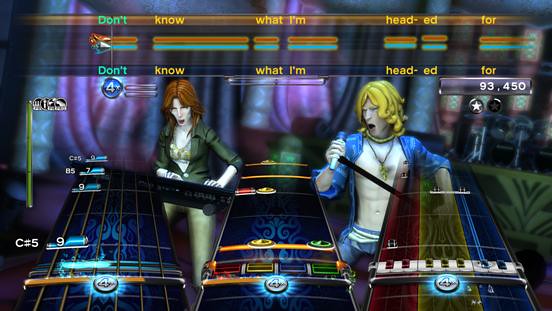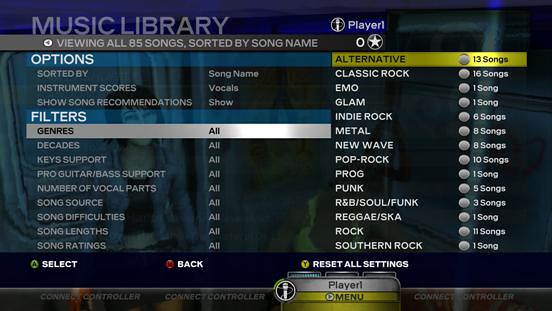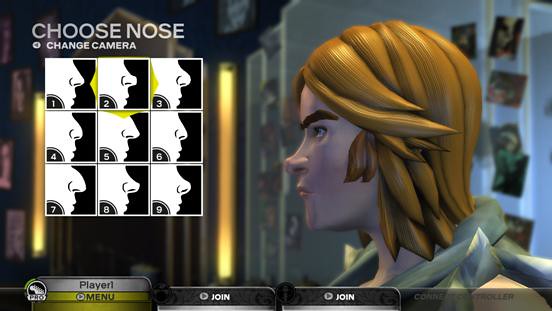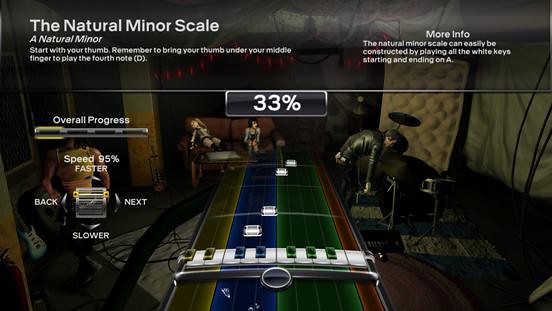Geekscape Reviews Rock Band 3!
The experience of Rock Band 3 is different right off the bat. The Rock Band franchise has a steady history of amusing intro cinematics, be it a polychromatic take on Queens of the Stone Age’s “Go With The Flow” music video or Beatles: Rock Band’s charming representation of the chronology of the world’s favorite band, but these cinematics were always fully animated. Rock Band 3 begins with a live-action video for The Doors’ “Break On Through,” and the message seems clear: Rock Band 3 will try to eliminate the artifice behind previous games in the franchise. You won’t be pushing buttons while a character on screen actually plays the real guitar. You, the player, will play a real guitar. Or a real keyboard. And all those jerks who took music lessons for years, the ones who always told you that if you devoted half the time you spent playing Rock Band to learning a “real instrument” you could be a “real musician” by now? They can officially suck it.
And so at last it has come to this… The rhythm game genre crosses the uncanny valley. More than just a ticker tape-punching simulator, EA’s eagerly anticipated new videogame Rock Band 3 at last utilizes instruments that are roughly equivalent to their real-world counterparts. The keyboard has actual keys, though only enough to suit one-handed playing. And the guitar has about eleventy-billion buttons on the fret to simulate actual guitar playing. These controllers just might represent a new revolution in music gaming, but then again they’re ridiculously expensive, and without them we’re left with just another Rock Band: Endlessly playable but merely tweaked from previous versions. Some changes are welcome, some are problematic, and at least one is pure evil.

All Pro Mode. Don’t try this at home. Oh wait… Do try this at home.
Rock Band 3 isn’t exactly Anna Karenina. I can’t imagine too many people disputing that. It’s a living, breathing mass of functionality, not a compelling narrative, so this review might end up reading like a laundry list of compliments and complaints. The compliments outweigh their competitors, thankfully, but I am nothing if not a critic (hence the job), so let’s get some of the annoyances out of the way first:
With the new keyboard, the game now supports up to five different instruments: Guitar, Bass, Keyboard, Drums and Vocals (up to three vocalists in songs supporting harmonies). In contrast, the Xbox 360 console only allows for four players signed in at a time. The only way to play with all instruments, which is really what this kind of “Party Game” was designed to support in the first place, is to basically turn the Vocals section into a mere karaoke-style of functionality as opposed to an active part of gameplay. Up to seven players are fully supportable online, apparently, but once again those of us with enough friends to play the game properly in our apartments are penalized for socializing in person. The option to activate all instruments is also annoyingly hidden away in the options menu, as if the game was trying to discourage you from even playing with five or more people, which once again is supposedly the point. Like I said, it’s annoying.

Rock Band 3 simplifies your set lists through the use of complicated menus. I kid, because it really works.
There’s also new feature in the Song Listings that provides “Recommended” song choices, presumably based on your playing or buying history. But no sooner do you go, “Oh dude, let’s totally play Stone Temple Pilots” than you discover, upon selecting the song, that it’s not actually available. “Recommended” songs are actually downloadable songs that EA and Harmonix have snuck into your existing game library, presumably with the intention of facilitating impulse buying. Congratulations, Rock Band 3: You’ve turned your licensed artists into chapstick. I declare this to be a dick move, and possibly even that classic kind of capitalistic Capraesque evil we used to be warned about all the time before the invention of Communism. (Or at least before the invention of demonizing Communism.)
Some of the old complaints about the Rock Band franchise, and indeed rhythm games in general, continue to rear their ugly heads. The only way to activate Star Power, or Overdrive, or whatever the hell else EA calls “Double Your Points” mode in Vocals is to make loud noises at certain points in the song, but it’s quite literally impossible to do so without sounding like a dork. At best you can sustain the note immediately prior to the Star Drive section (or, again, whatever the hell it’s supposed to be called… Oh, let’s be honest: we all just call it “Star Power”), but it always feels artificial. You inevitably end up feeling like that schmuck at karaoke who actually sings out “Musical Break Five Measures” whenever there’s a pause in the song because he’s socially awkward. I like to refer to this dickish behavior as “Cock Out With Your Rock Out.”

Pick your own nose? It really is just like the music industry!
And, worst of all, they eliminated the only hairstyle in the Character Creator that looked even vaguely like mine.
Everything else is awesome.
I repeat, everything else is awesome.
Rock Band 3 has a pleasing accessibility this time out. Gone is the arbitrary Career Mode progression that forced you to replay the same songs over and over again just to unlock new venues (which weren’t really that important anyway). Now, even songs in Quickplay count towards your experience points, can unlock costume items and so on. All songs are also unlocked from the beginning, which usually makes any kind of Career Mode redundant but again, incorporating Quickplay into the Career Mode itself is the perfect compromise.
New cinematics are interspersed throughout gameplay, replacing the (still classy) still images of your band from Rock Band 2. These cinematics are exceptionally well-animated but also brief enough that they never feel obtrusive. The proper balance has been struck between ease of play and an immersive fictional world.
While the Pro Guitar was not made available for review (and I just couldn’t afford to buy the danged thing on my own), the Pro Keyboard is a fine piece of machinery in its own right. The keys feel like a proper keyboard, with the proper weight and size requirements met, but it’s not a full keyboard, covering a mere two octaves. As such, Rachmaninoff is unlikely to be in Rock Band 3’s future. The cynic in me suspects this was a calculated financial move, since completely nailing the peripheral the first time out – something the Rock Band franchise isn’t exactly famous for – would reduce the profits on the inevitable Rock Band 4. But practicality also wins the day: It’s hard enough to learn this instrument one-handed, and there’s nothing preventing you from learning on a proper piano once you become accustomed to the peripheral. The keyboard also comes with a shoulder strap to facilitate what I like to call “80’s Mode,” but there’s an optional stand – which costs about $25 – which is easy to assemble, sturdy and fully adjustable. As a whole, the peripheral is highly recommended.

It’s not exactly Mrs. Badcrumble, but it’ll do: Rock Band 3‘s Pro Tutorials, fittingly, rock.
There’s a fine tutorial system that attempts to teach proper fingering (not that it can really tell when you’re hitting the right key with your thumb or not), but you’ll still be punching keys as colors zoom by the screen and not learning how to read actual, real music. Still, the Pro Keys gameplay mode is relatively easy to learn, particularly if you have any experience whatsoever with the instrument. I took piano lessons about 20 years ago (when I was a very little kid, I just want to point out, because that statement makes me feel very old), and it really helped me pick up and play. There’s a regular Keys gameplay mode too, but it’s practically for babies: Five notes on the keyboard in a row, and you play them like a fret without a strum bar. Lame, but good enough for Noobs.
Rock Band 3, for all its pomp and circumstance, still plays like Rock Band damn it. It’s endlessly replayable, the downloadable songs are plentiful and varied, and it’s the ideal party game of choice in almost any environment. There are some unpleasant tweaks that are worth griping about, but nothing that keeps the game from being a “Must Buy.”
